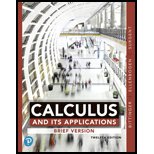
Concept explainers
Wind Chill Temperature.
Because wind speed enhances the loss of heat from the skin, we feel colder when there is wind than when there is not. The wind chill temperature is what the temperature would have to be with no wind in order to give the same chilling effect. The wind chill temperature, W, is given by
where T is the temperature measured by a thermometer, in degrees Fahrenheit, and v is the speed of the wind, in miles per hour. Find the wind chill temperature in each case. Round to the nearest degree.
Want to see the full answer?
Check out a sample textbook solution
Chapter 6 Solutions
CALCULUS+ITS APPLICATIONS
Additional Math Textbook Solutions
University Calculus: Early Transcendentals (4th Edition)
A Problem Solving Approach To Mathematics For Elementary School Teachers (13th Edition)
Calculus: Early Transcendentals (2nd Edition)
Introductory Statistics
Thinking Mathematically (6th Edition)
A First Course in Probability (10th Edition)
- The kinetic energy E of an object varies jointly with the object’s mass m and the square of the object’s velocity v . An object with a mass of 50 kilograms traveling at 16 meters per second has a kinetic energy of 6400 joules. What is the kinetic energy of an object with a mass of 70 kilograms traveling at 20 meters per second?arrow_forwardFind the unknown value. 27. y varies jointly with x and the cube root of 2. If when x=2 and z=27,y=12, find y if x=5 and z=8.arrow_forwardFind the intensity of light at a depth of 12 meter if I0=14 and k=0.7. Round to two decimals.arrow_forward
- Define Newton’s Law of Cooling. Then name at least three real-world situations where Newton’s Law of Cooling would be applied.arrow_forwardFind the constant of proportionality. y is directly proportional to x. If x=30, then y=15.arrow_forwardSolve each problem. w is directly proportional to z. If w=-6 when z=2, find w when z=-3.arrow_forward
- The resistance of a copper wire carrying an electrical current is directly proportional to its length and inversely proportional to its cross-sectional area. A copper wire with a diameter of 0.0126inch has a resistance of 64.9ohms per thousand feet. What length of 0.0201-inch-diameter copper wire will produce a resistance of 33.5ohms?arrow_forwardThe population Pinmillions of Texas from 2001 through 2014 can be approximated by the model P=20.913e0.0184t, where t represents the year, with t=1 corresponding to 2001. According to this model, when will the population reach 32 million?arrow_forwardIf you travel 300 miles on the first day and then drive v miles per hour for t hours on the second day, then the total distance traveled over the teo-day period is given by d=300+vt miles. Use a formula to express v as a function of d and t for this two-day event.arrow_forward
- A bowl of steamed rice is served at a dinner party. It starts to cool according to Newton's Law of Cooling. Its temperature T (measured in degrees Fahrenheit) after t minutes is given by T(t) = 77 + 180e-0.06tarrow_forwardThe windchill index announced during the winter by the weather bureau measures how cold it "feels" for a given temperature t (in degrees Fahrenheit) and wind speed w (in miles per hour). It is calculated by the formula C(t, w) = 35.74 + 0.6215t - 35.75w 0.16 + 0.4275tw0.16 + '.+ If the temperature is 31 degrees and the wind speed is 10 miles per hour, estimate the change in the windchill temperature if the wind speed increases by 4 miles per hour and the temperature drops by 5 degrees. (Round your answer to two decimal places.)arrow_forward
- Algebra & Trigonometry with Analytic GeometryAlgebraISBN:9781133382119Author:SwokowskiPublisher:Cengage
 Functions and Change: A Modeling Approach to Coll...AlgebraISBN:9781337111348Author:Bruce Crauder, Benny Evans, Alan NoellPublisher:Cengage Learning
Functions and Change: A Modeling Approach to Coll...AlgebraISBN:9781337111348Author:Bruce Crauder, Benny Evans, Alan NoellPublisher:Cengage Learning Glencoe Algebra 1, Student Edition, 9780079039897...AlgebraISBN:9780079039897Author:CarterPublisher:McGraw Hill
Glencoe Algebra 1, Student Edition, 9780079039897...AlgebraISBN:9780079039897Author:CarterPublisher:McGraw Hill  Trigonometry (MindTap Course List)TrigonometryISBN:9781337278461Author:Ron LarsonPublisher:Cengage Learning
Trigonometry (MindTap Course List)TrigonometryISBN:9781337278461Author:Ron LarsonPublisher:Cengage Learning
 Elementary AlgebraAlgebraISBN:9780998625713Author:Lynn Marecek, MaryAnne Anthony-SmithPublisher:OpenStax - Rice University
Elementary AlgebraAlgebraISBN:9780998625713Author:Lynn Marecek, MaryAnne Anthony-SmithPublisher:OpenStax - Rice University





